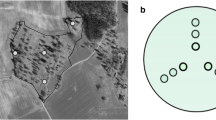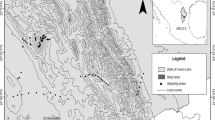Abstract
A classification of the microspecies of the genus Taraxacum was made in a range from low to highly dynamic habitats based on qualitative inventories of grasslands under different management conditions. After several years of constant management, a characteristic species composition occurs. Under mowing (hayfield) conditions, dandelions disappear over a period of about twenty years in a sequence where the low-dynamic species T. adamii and T. nordstedtii are the last to vanish. Different microspecies in the section Vulgaria in one field can show small differences in response to environmental conditions, even where no other directly visible indication exists. New appearance of highly dynamic species can indicate disturbance of some kind or other within a relatively short period.
The classification adopted seems to be correlated with the phosphate content of the soil. Differences in two easily perceptible morphological characteristics, namely position of the outer bracts and colour of the leaf-stem, fit into the established sequence. Small changes in these characteristics indicate conditions in the field that are improving or worsening from a nature-conservation point of view. A system is introduced in which merely these two morphological characters, without further taxonomical knowledge, can be used for an evaluation of grasslands and the impact of management practice.
Similar content being viewed by others
References
Dirkse, G.: 1977, ‘Remarks on Environmental Dynamics’, manuscript RIN Leersum (in Dutch).
Ellenberg, H.: 1974, ‘Zeigerwerte der Gefässpflanzen Mitteleuropas‘, Scripta Geobot, Göttingen 9, 1–97.
Hagendijk, A., Oosterveld, P., and Zevenbergen, H. A.: 1978, ‘Taraxacum vansoestii, spec. nov.’, Gorteria 9, 5, 166–170.
Kruyne, A. A., de Vries, D. M., and Mooi, H.: 1977, ‘Contribution to the Ecology of the Dutch Grassland Plants’, Versl. Landbouwk. Onderz. 696, 65 pp. (in Dutch with extensive summary).
Londo, G.: 1983, ‘On the Indicative Significance of the Occurrence of Plant Species’, Natura 80, 4, 188–193 (in Dutch).
Nordenstam, S. and van Soest, J. L.: 1974, ‘Taraxacum leporinum spec. nov.’, Bot. Not. 127, 490–492.
Oosterveld, P.: 1978, ‘The Indicative Significance of the Genus Taraxacum for the Management of Grasslands’, Gorteria 9, 5, 188–193 (in Dutch).
R.I.N.: 1979, Natuurbeheer in Nederland; Levensgemeenschappen, Pudoc, Wageningen, 392 pp (in Dutch).
Sterk, A. A.: 1982, ‘Introduction to the Genus Taraxacum in The Netherlands’, in Flora Neerlandica deel IV, afl. 10a, Kon. Bot. Ver., Amsterdam (in Dutch).
Zonneveld, I. S.: 1983, ‘Principles of Bio-Indication’, Environmental Monitoring and Assessment 3, 207–217 (this issue).
Author information
Authors and Affiliations
Rights and permissions
About this article
Cite this article
Oosterveld, P. Taraxacum species as environmental indicators for grassland management. Environ Monit Assess 3, 381–389 (1983). https://doi.org/10.1007/BF00396233
Received:
Issue Date:
DOI: https://doi.org/10.1007/BF00396233




